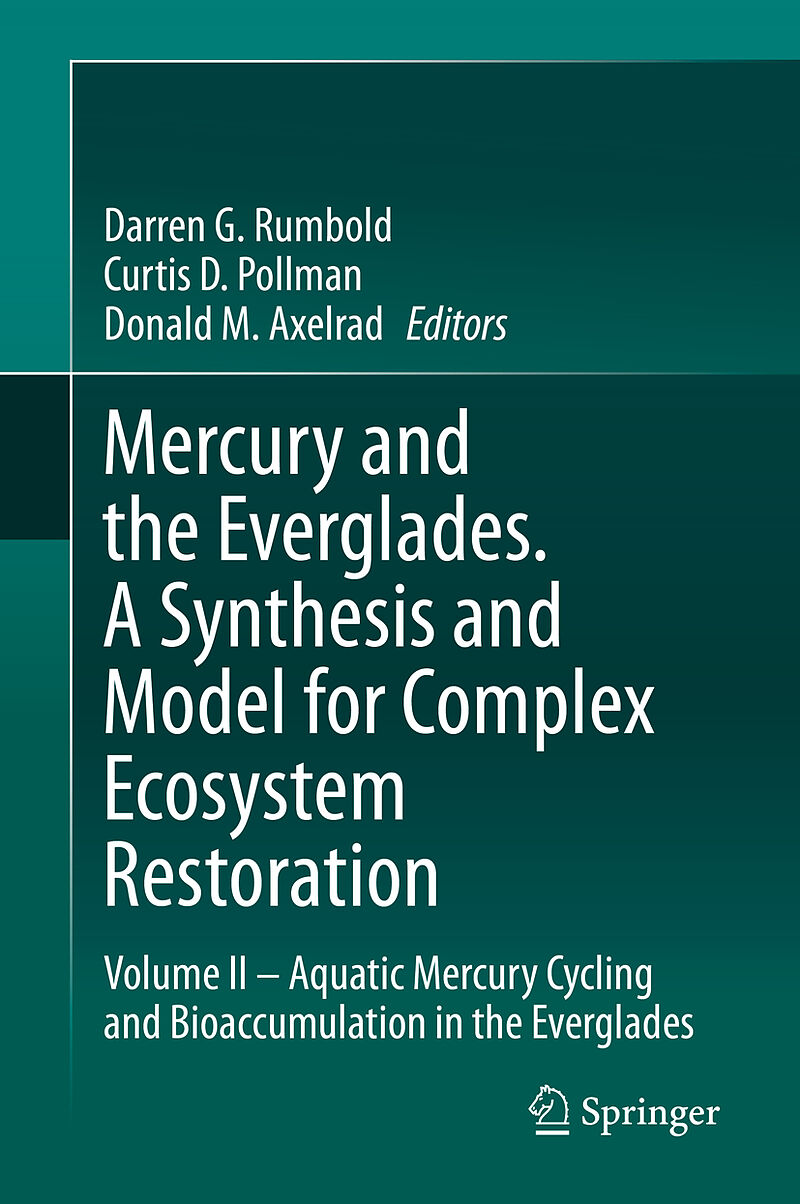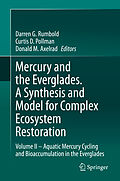

Mercury and the Everglades. A Synthesis and Model for Complex Ecosystem Restoration
Beschreibung
This book integrates 30 years of mercury research in the Florida Everglades to inform scientists and policy makers. The Everglades is an iconic ecosystem by virtue of its expanse; diversity of biota; and multiple international designations. Despite this, the E...Format auswählen
- Kartonierter EinbandCHF 165.60
- Fester EinbandCHF 104.85
- E-Book (pdf)CHF 95.10
Wird oft zusammen gekauft
Andere Kunden kauften auch
Beschreibung
This book integrates 30 years of mercury research in the Florida Everglades to inform scientists and policy makers. The Everglades is an iconic ecosystem by virtue of its expanse; diversity of biota; and multiple international designations. Despite this, the Everglades has been subjected to multiple threats including: habitat loss, hydrologic alterations, invasive species and altered water quality. Less well recognized as a threat to Everglades human use and wildlife populations is the toxic metal, mercury. The first half of Volume II focuses on biogeochemistry and factors unique to the Everglades that make it extraordinarily susceptible to mercury methylation following its deposition: warm subtropical climate, shallow depth, high levels of dissolved organic matter, sulfate contamination, nutrient enrichment and sediment redox conditions (for review of atmospheric mercury deposition significance, see Vol. I). The second half of Volume II answers the so what question why biomagnification of the methylmercury produced in the Everglades is a threat to the health of top predators including humans. The results of the synthesis presented in Volume II suggest that the mercury problem in the Florida Everglades is one of the worst in the world due to its areal extent and the degree of risk to ecological receptors and humans.
The Florida Everglades, an iconic ecosystem but with highly elevated foodchain mercury levels, is perhaps the world's most studied aquatic ecosystem with respect to the mercury problem This book integrates over 30 years of research on mercury sources, biogeochemistry, bioaccumulation and toxicity, and remediation options, to inform scientists and policy makers The proposed solution to the Everglades mercury problem as proposed by the State of Florida and accepted by the U.S. government will not result in toxicologically acceptable mercury levels in fish for many decades, and will therefore not make fish safe for human or wildlife consumption in the near term. As a result, this book reexamines Everglades' mercury science and evaluates the likely efficacy of other solutions
Autorentext
Darren Rumbold is a Professor of Marine Science and Director of the Coastal Watershed Institute at Florida Gulf Coast University (FGCU). He earned a BA in Chemistry and a BS and MS in Biology from Florida Atlantic University. He completed his Ph.D. in the Department of Marine Biology and Fisheries at University of Miami's Rosenstiel School of Marine and Atmospheric Science in 1996. In 1997, he was awarded a U.S. EPA Environmental Science & Engineering Fellowship at the National Center for Environmental Assessment in Washington, DC. From 1998-2006, he served as Senior- and, later, Lead Scientist with South Florida Water Management District (SFWMD) overseeing a program to learn the influential factors controlling mercury biogeochemistry, fate and effects in the Everglades. During his tenure, he served as Module lead under the Comprehensive Everglades Restoration Plan (CERP) coordinating efforts of state and federal agencies working on mercury. He also served as Technical lead for the Water Quality Team of the Southwest Florida Feasibility Study. In 2006, Dr. Rumbold joined the faculty of FGCU where he mentors students in taking a landscape-scale approach in assessing impacts of high-volume, freshwater discharges and the transport and fate of nutrients, mercury and other toxicants transported through the coastal watershed. As principal investigator (PI) or co-PI, he has secured millions in extramural funding for research; most recently, up to $4.1 million to provide ecological and environmental scientific support, on an as-needed basis, to the SFWMD. Dr. Pollman is currently the CEO of Aqua Lux Lucis, Inc. and adjunct research professor in the Department of Geological Sciences at the University of Florida. He also holds a position as Chief Science Officer for Nclear, Inc., which is a start-up venture seeking to commercialize the applications of a novel synthetic calcium silicate mineral for treating water and wastewater. He obtained his Ph.D. in environmental engineering sciences from the University of Florida in 1983 where he specialized in aquatic chemistry and limnology. Dr. Pollman has been involved in various research projects relating to mercury (Hg) cycling in the environment, including the Everglades, since 1994. This research spanned his tenure with Tetra Tech's Research & Development Division between 1995 and 2006, where he both led the Florida Atmospheric Mercury Study (FAMS) and participated in modifications to the Mercury Cycling Model (MCM) and subsequent application to the Florida Everglades. Between 2005 and 2007, he served as the CEO and Chief Scientist for Frontier Geosciences, Inc. (FGS), a small, highly specialized laboratory that was then widely acknowledged as one of the pre-eminent commercial laboratories worldwide analyzing Hg and other trace elements at ambient concentrations in natural waters. Dr. Pollman left Frontier Geosciences in late 2007 to form Aqua Lux Lucis with the express goal of conducting applied research and analysis to help inform decision makers devise environmental policy and strategies with a more robust understanding of the likely outcomes and uncertainties inherent in the decision making. This work includes using deterministic and statistical models to elucidate processes governing response variable dynamics in complex systems and using these models as tools to place in context and help resolve complex environmental problems.
Donald M. Axelrad, Ph.D. is an Associate Professor of Environmental Health in the Institute of Public Health, College of Pharmacy, at Florida A&M University (FAMU). He earned a B.S. degree in Chemistry from Wayne State University, an M.S. in Environmental & Industrial Health from the University of Michigan, and a Ph.D. in Marine Science from the College of William and Mary. Prior to joining FAMU, from 1996-2013 while with the Florida Department of Environmental Protection, Dr. Axelrad had responsibilities for writing and editing the annual 'Mercury and Sulfur Environmental Assessment' chapter of the 'South Florida Environmental Report' (SFER). This peer-reviewed publication - mandated by Florida's (1994) Everglades Forever Act - is issued annually and summarizes "all data and findings of the State's mercury monitoring and research in South Florida".The SFER chapter concerns the magnitude and extent of the Everglades mercury problem, mercury sources to the Everglades, mercury biogeochemistry, bioaccumulation, human and wildlife toxicology, and options for mitigating the mercury problem. At FAMU, Dr. Axelrad teaches Environmental Health and Environmental Toxicology, remains involved in research on mercury exposure to women of childbearing age, as well as on lead exposure in children.
Inhalt
- Aquatic Cycling of Mercury. - Sulfur Contamination in the Everglades, a Major Control on Mercury Methylation. - A Causal Analysis for the Dominant Factor in the Extreme Geographic and Temporal Variability in Mercury Biomagnification in the Everglades. - Dissolved Organic Matter Interactions with Mercury in the Florida Everglades. - Phosphorus in the Everglades and Its Effects on Oxidation-Reduction Dynamics. - Major Drivers of Mercury Methylation and Cycling in the Everglades: A Synthesis. - Primer on Methylmercury Biomagnification in the Everglades. - Food Web Structures of Biotically Important Species. - Comparison of Everglades Fish Tissue Mercury Concentrations to Those for Other Fresh Waters. - Regional-Scale Ecological Risk Assessment of Mercury in the Everglades and South Florida. - Everglades Mercury: Human Health Risk.- Mercury Biomagnification Through Everglades' Food Webs and the Resulting Risk for Environmental and Human Health: A Synthesis.
